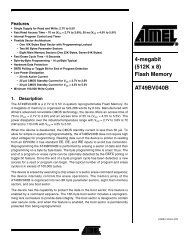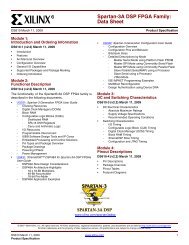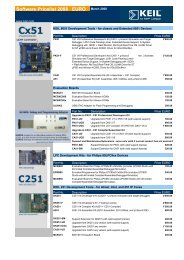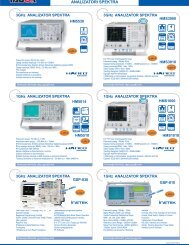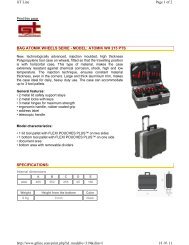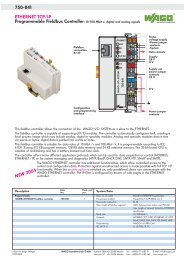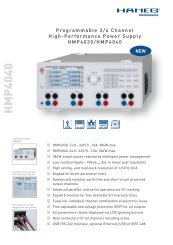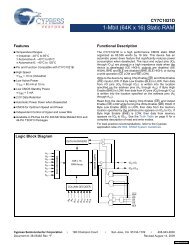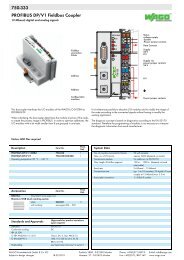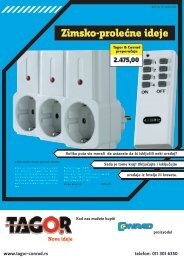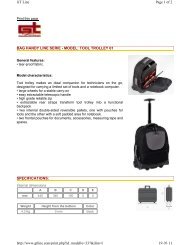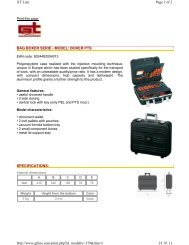PIC12F683 Data Sheet - Microchip
PIC12F683 Data Sheet - Microchip
PIC12F683 Data Sheet - Microchip
Create successful ePaper yourself
Turn your PDF publications into a flip-book with our unique Google optimized e-Paper software.
<strong>PIC12F683</strong><br />
10.2 Reading the EEPROM <strong>Data</strong><br />
Memory<br />
To read a data memory location, the user must write the<br />
address to the EEADR register and then set control bit<br />
RD of the EECON1 register, as shown in Example 10-1.<br />
The data is available, at the very next cycle, in the<br />
EEDAT register. Therefore, it can be read in the next<br />
instruction. EEDAT holds this value until another read, or<br />
until it is written to by the user (during a write operation).<br />
EXAMPLE 10-1:<br />
DATA EEPROM READ<br />
10.3 Writing to the EEPROM <strong>Data</strong><br />
Memory<br />
To write an EEPROM data location, the user must first<br />
write the address to the EEADR register and the data<br />
to the EEDAT register. Then the user must follow a<br />
specific sequence to initiate the write for each byte, as<br />
shown in Example 10-2.<br />
EXAMPLE 10-2:<br />
Required<br />
Sequence<br />
BANKSEL EEADR ;<br />
MOVLW CONFIG_ADDR ;<br />
MOVWF EEADR ;Address to read<br />
BSF EECON1,RD ;EE Read<br />
MOVF EEDAT,W ;Move data to W<br />
DATA EEPROM WRITE<br />
BANKSEL EECON1 ;<br />
BSF EECON1,WREN ;Enable write<br />
BCF INTCON,GIE ;Disable INTs<br />
BTFSC INTCON,GIE ;See AN576<br />
GOTO $-2 ;<br />
MOVLW 55h ;Unlock write<br />
MOVWF EECON2 ;<br />
MOVLW AAh ;<br />
MOVWF EECON2 ;<br />
BSF EECON1,WR ;Start the write<br />
BSF INTCON,GIE ;Enable INTS<br />
The write will not initiate if the above sequence is not<br />
exactly followed (write 55h to EECON2, write AAh to<br />
EECON2, then set WR bit) for each byte. We strongly<br />
recommend that interrupts be disabled during this<br />
code segment. A cycle count is executed during the<br />
required sequence. Any number that is not equal to the<br />
required cycles to execute the required sequence will<br />
prevent the data from being written into the EEPROM.<br />
Additionally, the WREN bit in EECON1 must be set to<br />
enable write. This mechanism prevents accidental<br />
writes to data EEPROM due to errant (unexpected)<br />
code execution (i.e., lost programs). The user should<br />
keep the WREN bit clear at all times, except when<br />
updating EEPROM. The WREN bit is not cleared<br />
by hardware.<br />
After a write sequence has been initiated, clearing the<br />
WREN bit will not affect this write cycle. The WR bit will<br />
be inhibited from being set unless the WREN bit is set.<br />
At the completion of the write cycle, the WR bit is<br />
cleared in hardware and the EE Write Complete<br />
Interrupt Flag bit (EEIF) is set. The user can either<br />
enable this interrupt or poll this bit. The EEIF bit of the<br />
PIR1 register must be cleared by software.<br />
10.4 Write Verify<br />
Depending on the application, good programming<br />
practice may dictate that the value written to the data<br />
EEPROM should be verified (see Example 10-3) to the<br />
desired value to be written.<br />
EXAMPLE 10-3:<br />
WRITE VERIFY<br />
BANKSELEEDAT ;<br />
MOVF EEDAT,W ;EEDAT not changed<br />
;from previous write<br />
BSF EECON1,RD ;YES, Read the<br />
;value written<br />
XORWF EEDAT,W<br />
BTFSS STATUS,Z ;Is data the same<br />
GOTO WRITE_ERR ;No, handle error<br />
: ;Yes, continue<br />
10.4.1 USING THE DATA EEPROM<br />
The data EEPROM is a high-endurance, byte<br />
addressable array that has been optimized for the<br />
storage of frequently changing information (e.g.,<br />
program variables or other data that are updated often).<br />
When variables in one section change frequently, while<br />
variables in another section do not change, it is possible<br />
to exceed the total number of write cycles to the<br />
EEPROM (specification D124) without exceeding the<br />
total number of write cycles to a single byte<br />
(specifications D120 and D120A). If this is the case,<br />
then a refresh of the array must be performed. For this<br />
reason, variables that change infrequently (such as<br />
constants, IDs, calibration, etc.) should be stored in<br />
Flash program memory.<br />
© 2007 <strong>Microchip</strong> Technology Inc. DS41211D-page 73



